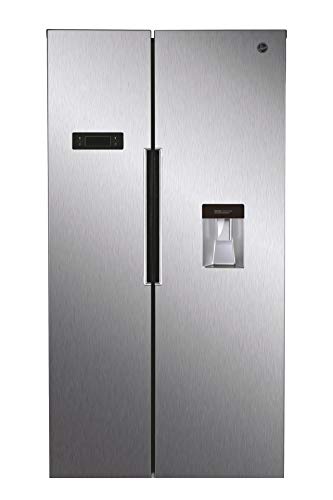Five Killer Quora Answers On Refridgerator UK
페이지 정보

본문
The History of the Refrigerator
The conventional refrigeration of foods produces significant greenhouse gas emissions due to refrigerant leakage, and electrical power consumption. In 2019 the amount of emissions was 3.2 percent of the total UK annual territorial GHG emissions.
Refrigerators were not widespread in British homes until the summer of 1959. Prior to that, the majority of households relied on cold slabs in pantries. They were inefficient and could not maintain an even temperature.
The History of Fridges In The UK
Refrigerators are among the most important kitchen appliances that allow us to keep our food and drinks fresh for a few days at one time. They're also extremely energy efficient. It's easy, though, to forget that refrigerators were once a luxury item. It wasn't really until the 1950s when they started to gain popularity. It was an extremely hot British summer that made them popular.
Before refrigerators were invented, people relied on insulated iceboxes to keep their food cool. In the winter, they would collect blocks of ice on lakes and store them for warmer months. These ice boxes were far from ideal, though. These ice boxes were heavy and needed to be carried by an "ice man". In 1918 the first electric refrigerators were introduced to the market. However, it took a long time before they were used in homes.
The efficiency of refrigerators in terms of energy use has improved significantly over time. They consume less energy than they did ten years ago. Some refrigerators consume only 4 kW*h per day (equivalent of 170 W continuously). The majority of refrigerators in the US are energy-efficient, with the majority being rated A+.
In the 1950s, manufacturers began to introduce refrigerators with separate freezer compartments. They also began producing models with a chrome finish which was very popular at the time. Since the time, refrigerators are now available in many different colours and finishes. Pastel shades, like pink and turquoise were very popular in the 1960s. Earth tone colors, like almond and avocado green, became more popular in the 1970s and 1980s. By the 90s stainless steel started to dominate.
Fridges in the 1920s
Before fridges people made use of wooden "ice boxes" to store food and drinks that were fresh. Icemen would bring blocks of ice to fill them up and they would keep cool all year round. Ice boxes were typically located in kitchens of wealthy households.
In 1918, the first electric refrigerator was introduced. It was atop the existing icebox in a house. They were large noisy and expensive. The motor was located on the top of the cabinet. They were also known as monitor-tops. William C. Durant purchased the Mellowes Refrigerator Company in 1918 and founded the Guardian Frigidaire to mass-produce refrigerators. Durant was inspired by a design developed by Cistercian monk Marcel Audiffren and Swiss engineer Albert Singrun. It was an absorption refrigerator, using sulfur dioxide as the refrigerant.
In the 1920s, these new refrigerators became affordable for many homes. They were able to accommodate more food and drink and stayed cooler longer than the old ice boxes.
The advertisements on refrigerators were imaginative, enticing and filled with promises of ice-cold beverages and stylish designs. These ads are fascinating to read as they give us a glimpse into the world of in the past.
By the end the 1920s, electric refrigerators were installed in nearly all homes. Electric utilities encouraged this trend by offering rebates on their bills to customers who bought refrigerators. The popularity of these appliances increased even more during the Great Depression when they were considered to be essential for the survival of a home.
Fridges in the 1950s
Refrigerators were still scarce in the 1920s but became increasingly commonplace during the 1950s. By the late 1960's they were a common sight in most homes (although it is worth noting that you probably wouldn't find a refrigerator in every home in those days, as this was an expensive expense for many).
The majority of early fridges were very utilitarian appliances with simple designs that matched the kitchen decor of the day. The refrigerators were typically smaller and sat on legs. They were available in a range of colors (though the majority were pastels like mint). In the time of this, there were a number of fridge freezers for sale manufacturers, including Whirlpool (who had just emerged as a leading brand), Gibson, Hotpoint and Tappan.
These brands were all known for high-quality and reliable refrigerators. They also expanded their product ranges, offering other types of household appliances. For instance, Crosley was a manufacturer of radios prior to their move into refrigerators in the 1940's and were famous for their small refrigerators that could be tucked away in smaller space.
In the 1950's, fridges grew more stylish and were promoted as an emblem of status for housewives. They were designed in a way that was in line with the cabinets and the walls of the kitchen. They were usually white with chrome handles.
Then in the '60s refrigerators began to evolve into gadget-centric appliances with features like separate freezers and ice cube makers. In addition manufacturers began using less expensive materials and were able to offer these appliances at much lower costs.
Fridges in 1960s
In the 1960s, refrigerators became a necessity in many households. Some families even had two refrigerators. In the 1960s, the average American fridge freezer collection cost $600 (roughly $7000 in 2024 dollars). By the end of the decade, prices was down to $200.
The refrigerator was a significant advancement at the time. It transformed kitchens and changed the way we stored our food. The fridge was also a great home comfort as it kept meat and dairy longer in freshness. This made it possible to purchase bulk quantities prepare meals in advance and then store them.
The first refrigerators used harmful gases like ammonia, methyl chloride, and sulfur dioxide to cool food, but this was dangerous for humans since these gases were released from refrigerators. In 1929, carbon dioxide was introduced as a safe way to cool food. A number of people were poisoned and died.
This means that manufacturers were able to design safer and more efficient refrigerators that could be used in homes, with certain refrigerators having an inside freezer compartment that could be accessed by opening the fridge door. These were referred to as bi-door refrigerators and were popular during the 1950s and 1960s.
The refrigerators of the 1960s were more futuristic than the ones of today, featuring soft curves and a elegant design that reflected an era of efficiency and freedom for the home. The refrigerators were still big however the boxy style of the 1940s was fading.
Refrigerators today
Modern fridge freezer near me freezers are available in a variety of colors styles, designs and finishes that can be customized to fit your kitchen and personal taste. Certain fridge freezers feature smart features that connect to Wi-Fi. This allows you to quickly customize the settings. Some even come with a built in camera to look inside your refrigerator.
French door models now dominate the market, since consumers are looking for modern designs and features like water or ice dispensers and flex drawers. In some cases, a smart display. Many are also rated A, B, or A+ in energy efficiency ratings, following a shake-up of the mandatory labelling scheme for refridgerator Uk [willysforsale.Com] appliances.
This Hotpoint model is a popular choice due to its sleek design. It comes with a clever UVNano self-sterilizing technology that kills bacteria in the fridge. Additionally, it comes with two salad drawers with adjustable humidity sliders. It's also spacious, with plenty of room for jars, bottles and a generous utility compartment in the fridge's door.
Find fridges that have the eco-friendly ICE+ feature that uses less energy. You can also save more money by selecting one that comes with an automatic ice maker. This will create an ongoing supply of ice that is ready to be used in the morning.
The most effective way to protect the environment is to purchase refrigerators that have an energy efficiency rating of either A or A+. It's also a good idea to think about the refrigerator's annual consumption of electricity as a part of your budget for household appliances when you're deciding on an appliance. It is crucial to remember that we can't afford think of electricity as a luxury. Everyone deserves to have access to reliable, affordable and plentiful electricity to lead a healthy lifestyle and be comfortable. ensure the protection of our planet.
The conventional refrigeration of foods produces significant greenhouse gas emissions due to refrigerant leakage, and electrical power consumption. In 2019 the amount of emissions was 3.2 percent of the total UK annual territorial GHG emissions.
Refrigerators were not widespread in British homes until the summer of 1959. Prior to that, the majority of households relied on cold slabs in pantries. They were inefficient and could not maintain an even temperature.
The History of Fridges In The UK
Refrigerators are among the most important kitchen appliances that allow us to keep our food and drinks fresh for a few days at one time. They're also extremely energy efficient. It's easy, though, to forget that refrigerators were once a luxury item. It wasn't really until the 1950s when they started to gain popularity. It was an extremely hot British summer that made them popular.
Before refrigerators were invented, people relied on insulated iceboxes to keep their food cool. In the winter, they would collect blocks of ice on lakes and store them for warmer months. These ice boxes were far from ideal, though. These ice boxes were heavy and needed to be carried by an "ice man". In 1918 the first electric refrigerators were introduced to the market. However, it took a long time before they were used in homes.
The efficiency of refrigerators in terms of energy use has improved significantly over time. They consume less energy than they did ten years ago. Some refrigerators consume only 4 kW*h per day (equivalent of 170 W continuously). The majority of refrigerators in the US are energy-efficient, with the majority being rated A+.
In the 1950s, manufacturers began to introduce refrigerators with separate freezer compartments. They also began producing models with a chrome finish which was very popular at the time. Since the time, refrigerators are now available in many different colours and finishes. Pastel shades, like pink and turquoise were very popular in the 1960s. Earth tone colors, like almond and avocado green, became more popular in the 1970s and 1980s. By the 90s stainless steel started to dominate.
Fridges in the 1920s
Before fridges people made use of wooden "ice boxes" to store food and drinks that were fresh. Icemen would bring blocks of ice to fill them up and they would keep cool all year round. Ice boxes were typically located in kitchens of wealthy households.
In 1918, the first electric refrigerator was introduced. It was atop the existing icebox in a house. They were large noisy and expensive. The motor was located on the top of the cabinet. They were also known as monitor-tops. William C. Durant purchased the Mellowes Refrigerator Company in 1918 and founded the Guardian Frigidaire to mass-produce refrigerators. Durant was inspired by a design developed by Cistercian monk Marcel Audiffren and Swiss engineer Albert Singrun. It was an absorption refrigerator, using sulfur dioxide as the refrigerant.
In the 1920s, these new refrigerators became affordable for many homes. They were able to accommodate more food and drink and stayed cooler longer than the old ice boxes.
The advertisements on refrigerators were imaginative, enticing and filled with promises of ice-cold beverages and stylish designs. These ads are fascinating to read as they give us a glimpse into the world of in the past.
By the end the 1920s, electric refrigerators were installed in nearly all homes. Electric utilities encouraged this trend by offering rebates on their bills to customers who bought refrigerators. The popularity of these appliances increased even more during the Great Depression when they were considered to be essential for the survival of a home.
Fridges in the 1950s
Refrigerators were still scarce in the 1920s but became increasingly commonplace during the 1950s. By the late 1960's they were a common sight in most homes (although it is worth noting that you probably wouldn't find a refrigerator in every home in those days, as this was an expensive expense for many).
The majority of early fridges were very utilitarian appliances with simple designs that matched the kitchen decor of the day. The refrigerators were typically smaller and sat on legs. They were available in a range of colors (though the majority were pastels like mint). In the time of this, there were a number of fridge freezers for sale manufacturers, including Whirlpool (who had just emerged as a leading brand), Gibson, Hotpoint and Tappan.
These brands were all known for high-quality and reliable refrigerators. They also expanded their product ranges, offering other types of household appliances. For instance, Crosley was a manufacturer of radios prior to their move into refrigerators in the 1940's and were famous for their small refrigerators that could be tucked away in smaller space.
In the 1950's, fridges grew more stylish and were promoted as an emblem of status for housewives. They were designed in a way that was in line with the cabinets and the walls of the kitchen. They were usually white with chrome handles.
Then in the '60s refrigerators began to evolve into gadget-centric appliances with features like separate freezers and ice cube makers. In addition manufacturers began using less expensive materials and were able to offer these appliances at much lower costs.
Fridges in 1960s
In the 1960s, refrigerators became a necessity in many households. Some families even had two refrigerators. In the 1960s, the average American fridge freezer collection cost $600 (roughly $7000 in 2024 dollars). By the end of the decade, prices was down to $200.
The refrigerator was a significant advancement at the time. It transformed kitchens and changed the way we stored our food. The fridge was also a great home comfort as it kept meat and dairy longer in freshness. This made it possible to purchase bulk quantities prepare meals in advance and then store them.
The first refrigerators used harmful gases like ammonia, methyl chloride, and sulfur dioxide to cool food, but this was dangerous for humans since these gases were released from refrigerators. In 1929, carbon dioxide was introduced as a safe way to cool food. A number of people were poisoned and died.
This means that manufacturers were able to design safer and more efficient refrigerators that could be used in homes, with certain refrigerators having an inside freezer compartment that could be accessed by opening the fridge door. These were referred to as bi-door refrigerators and were popular during the 1950s and 1960s.
The refrigerators of the 1960s were more futuristic than the ones of today, featuring soft curves and a elegant design that reflected an era of efficiency and freedom for the home. The refrigerators were still big however the boxy style of the 1940s was fading.
Refrigerators today
Modern fridge freezer near me freezers are available in a variety of colors styles, designs and finishes that can be customized to fit your kitchen and personal taste. Certain fridge freezers feature smart features that connect to Wi-Fi. This allows you to quickly customize the settings. Some even come with a built in camera to look inside your refrigerator.
French door models now dominate the market, since consumers are looking for modern designs and features like water or ice dispensers and flex drawers. In some cases, a smart display. Many are also rated A, B, or A+ in energy efficiency ratings, following a shake-up of the mandatory labelling scheme for refridgerator Uk [willysforsale.Com] appliances.
This Hotpoint model is a popular choice due to its sleek design. It comes with a clever UVNano self-sterilizing technology that kills bacteria in the fridge. Additionally, it comes with two salad drawers with adjustable humidity sliders. It's also spacious, with plenty of room for jars, bottles and a generous utility compartment in the fridge's door.
Find fridges that have the eco-friendly ICE+ feature that uses less energy. You can also save more money by selecting one that comes with an automatic ice maker. This will create an ongoing supply of ice that is ready to be used in the morning.
The most effective way to protect the environment is to purchase refrigerators that have an energy efficiency rating of either A or A+. It's also a good idea to think about the refrigerator's annual consumption of electricity as a part of your budget for household appliances when you're deciding on an appliance. It is crucial to remember that we can't afford think of electricity as a luxury. Everyone deserves to have access to reliable, affordable and plentiful electricity to lead a healthy lifestyle and be comfortable. ensure the protection of our planet.

- 이전글What's The Current Job Market For 30ft High Cube Shipping Container Professionals? 25.04.03
- 다음글Sofas On Sale Tools To Help You Manage Your Daily Life Sofas On Sale Trick That Should Be Used By Everyone Learn 25.04.03
댓글목록
등록된 댓글이 없습니다.



 02.6010.5010
02.6010.5010




